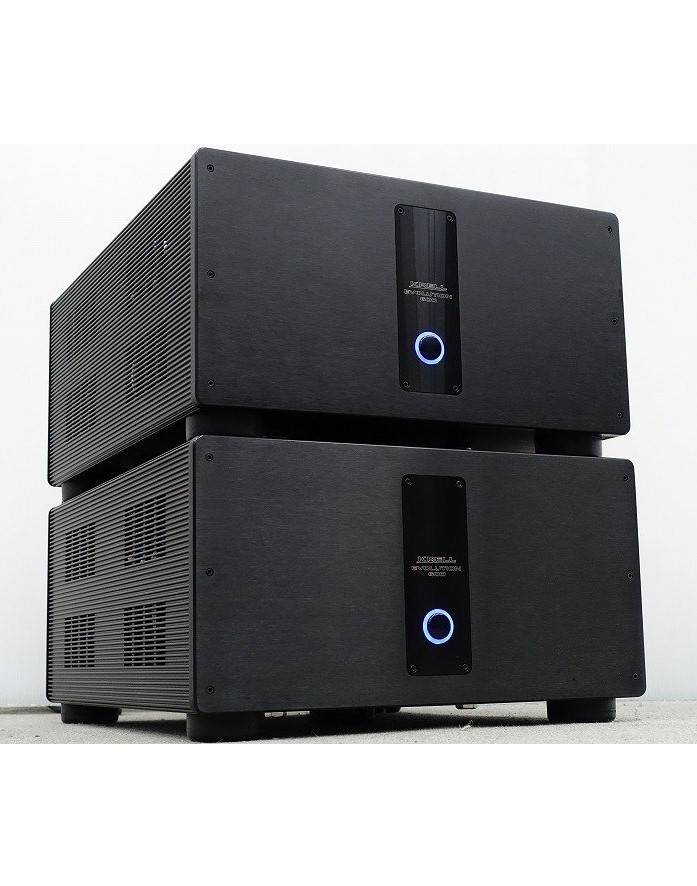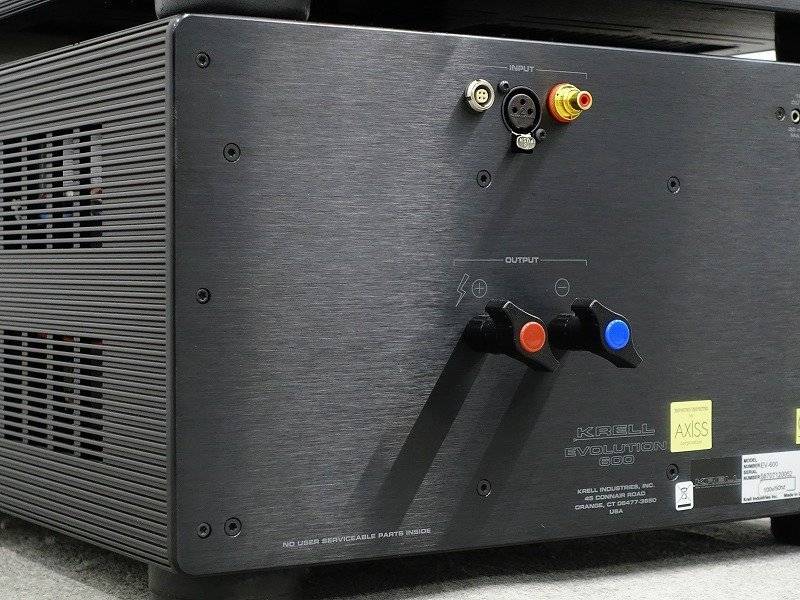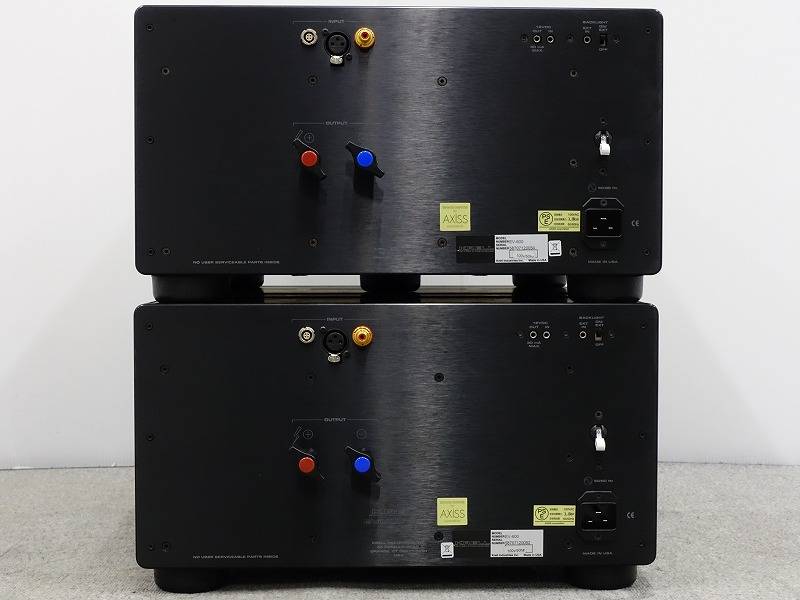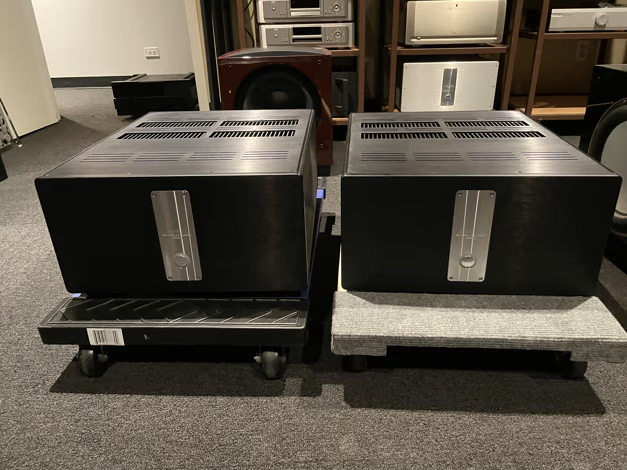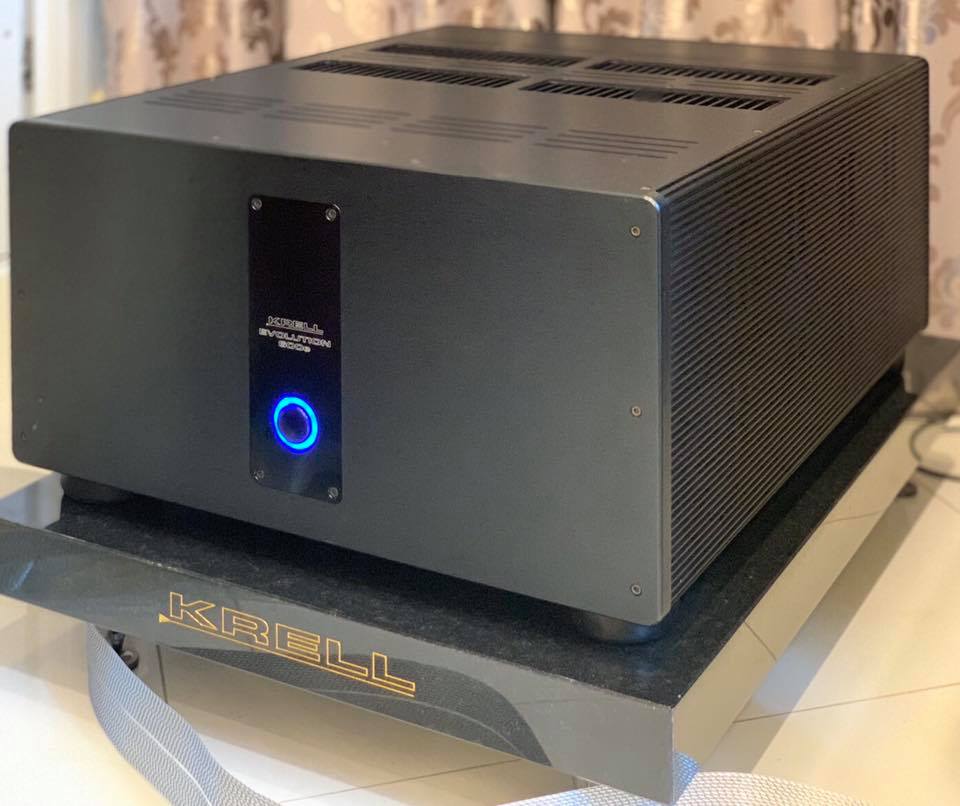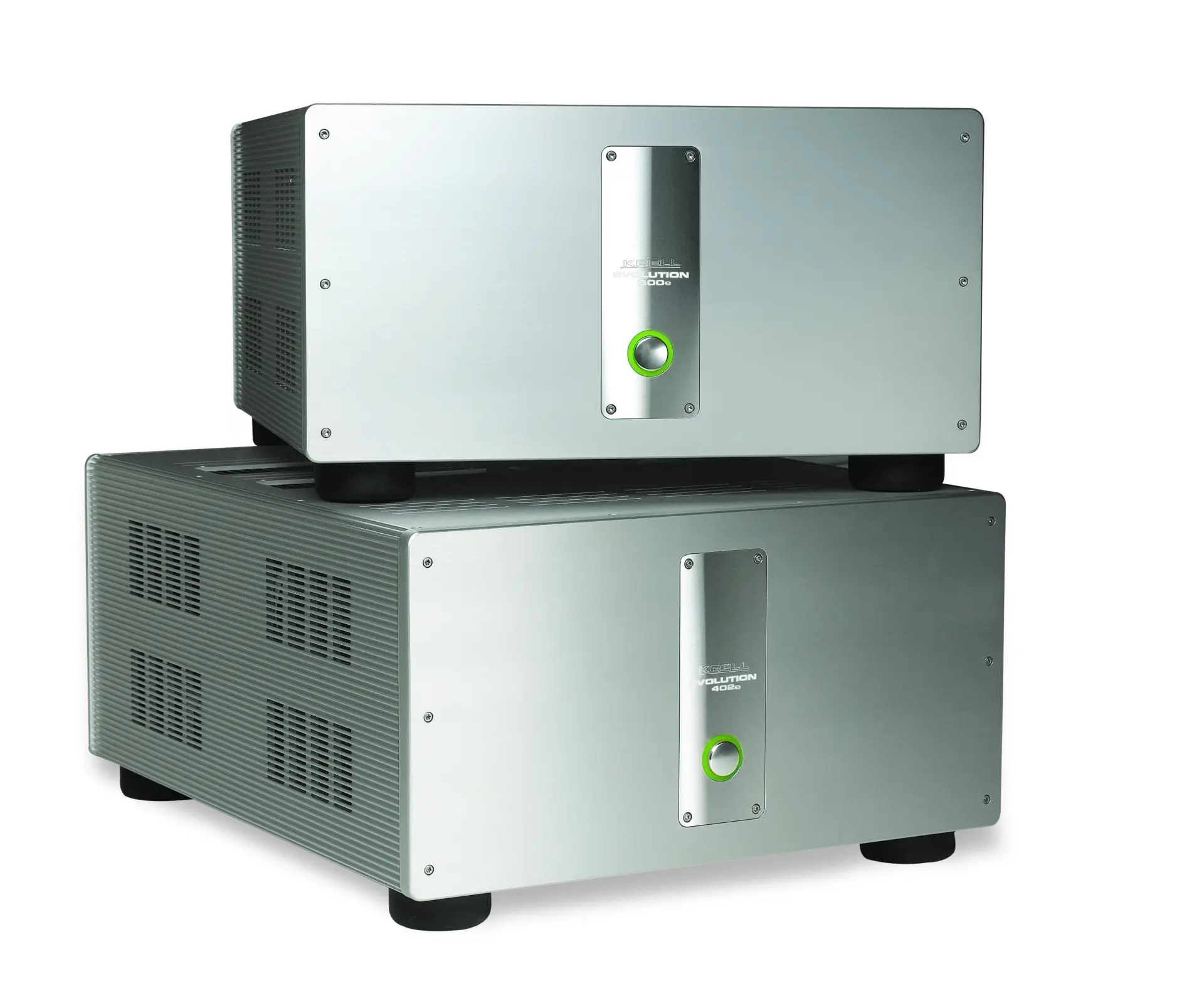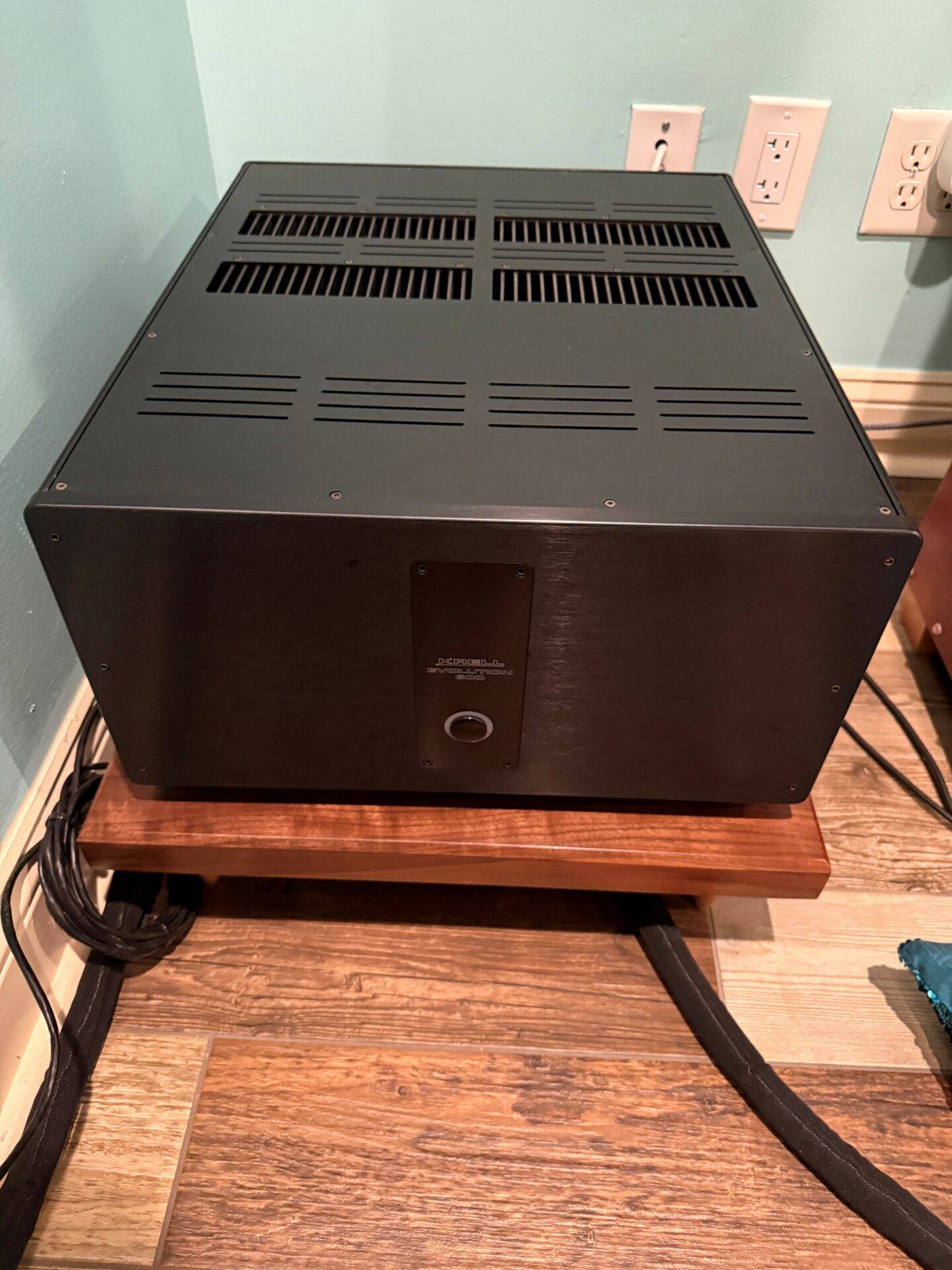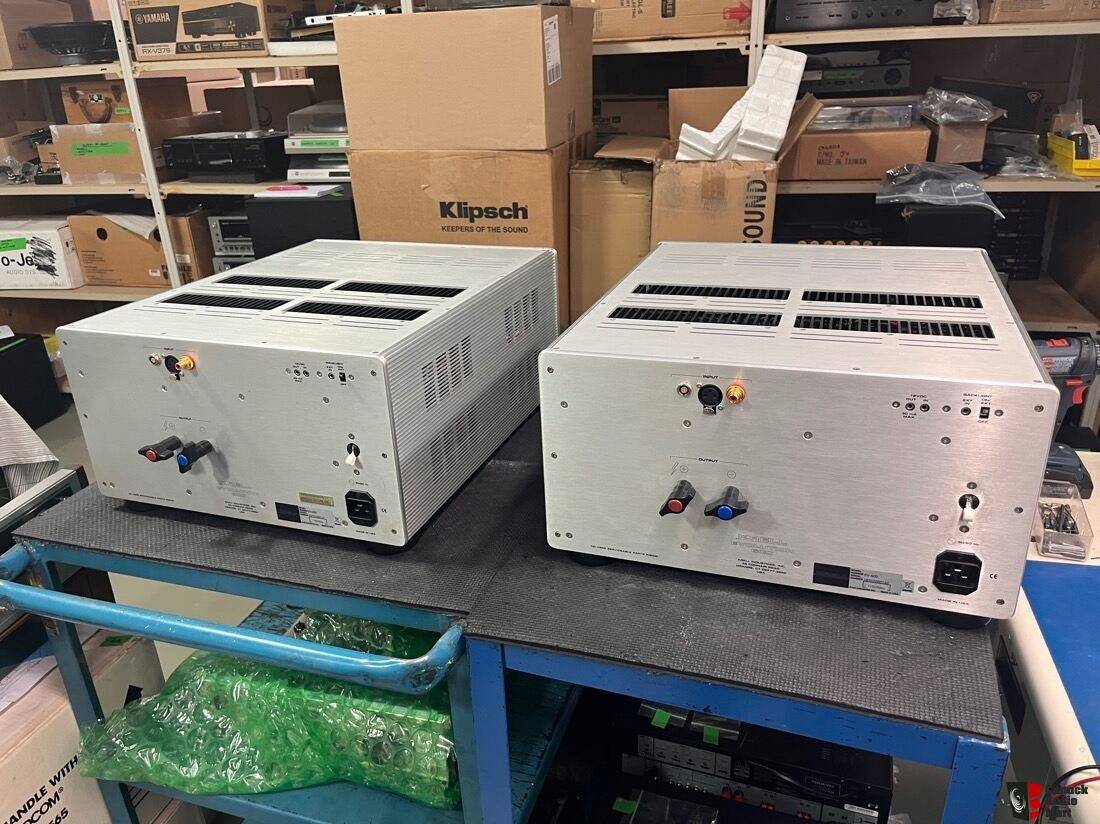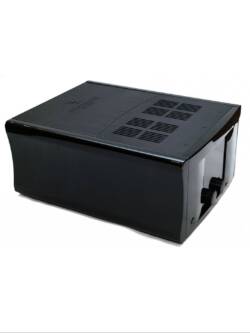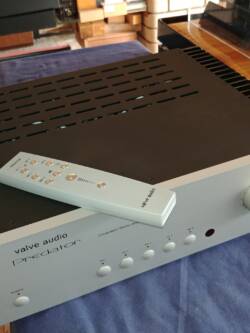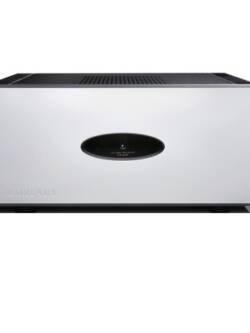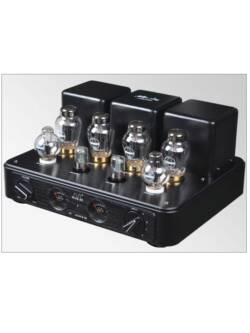Krell Evolution 600 Monoblocks (600W/8)
Original price was: R580,000.00.R250,000.00Current price is: R250,000.00.
The Krell Evolution 600 monoblock power amplifier delivers 600W RMS into 8 ohms (1200W into 4 ohms), features CAST, balanced, and single-ended inputs, and boasts a slew rate of 100V/µs,
with dimensions of 17.25″ (438mm) W by 9.75″ (248mm) H by 22.05″ (560mm) D and a
weight of 135 lbs (61.1 kg).
The Evolution 600 achieves a full 670W/8ohm and
virtually doubles this with 1.32kW/4ohm
followed by 2.62kW/2ohm which must put it as the ‘stiffest’ power amp on the planet.
Description
Talk about going from the ridiculous to the sublime. One day I’m reviewing the $139 Sonic Impact Super T power amplifier, and the next day Krell Industries delivers their $10,000 Evolution 505 SACD/CD player, $15,000 Evolution 202 preamplifier, and their $30,000/pair Evolution 600 monoblocks.
And I whined. “I don’t like to review complete systems,” I moaned to Krell’s Randy Bingham. “That’s too many changes, and it takes forever to do comparisons.”
“We don’t want to impose, but with the CAST current gain system, the only way you can evaluate how good any individual component is is to hear it in concert with the other components running CAST. That way, from source to output, the system consists of a single gain stage, which is about as simple as it gets. Besides, we don’t want you to review the universal player—we promised it to Fremer.”
“Okay, but I’m going to listen to my reference Ayre C-5xe player, Conrad-Johnson CT5 preamp, and Musical Fidelity Nu-Vista 300 in the system, not just the other CAST gear.”
“Actually, we insist on it—and while you’re at it, disconnect the CAST cables and hear the Evolutions in balanced and single-ended modes. We’re convinced that even an audio reviewer—um, I mean, especially an audio reviewer—will hear the difference.”
Oooh, a challenge. I love a challenge—especially a cheeky one.
Evolution of a technology
The Evolution 202 and 600 are jam-packed with technological buzzwords (not to mention the technology that drives them), so I’ll just surf the highlights and point you to Krell’s website for the complete list.
The 202 is a two-chassis design; the power supply, with its quad-rectified 170VA toroidal transformer and 39,600µF of filter capacitance, is housed in its own shielded chassis. The volume is controlled through a balanced 16-bit resistor ladder. The signal path is a zero-feedback, high-bandwidth, 1.5MHz open loop in a balanced Krell Current Mode design, terminating in Krell CAST (Current Audio Signal Transmission).
CAST uses Krell’s Current Mode Technology (CMT) to transmit the signal as current rather than voltage. Normally, you’d want a system’s preamp output to be low and the power amplifier’s impedance to be high, but that creates a situation in which the interconnect’s impedance could affect—even distort—the signal voltage operating the amplifier. CAST, says Krell, transfers current from a high-impedance source to a low-impedance load, essentially eliminating the cable’s effect on signal transmission. And, if you’re using a CAST CD player, the signal can be taken straight off the DACs without going through a current–voltage conversion stage.
That, says Krell’s CEO and chief designer, Dan D’Agostino, is crucial. When D’Agostino was working on Krell’s CMT, “I noticed that every time we did an I-to-V conversion, the converter added noise and grain and messed with detail, so I just said, ‘Wouldn’t it be wonderful if we didn’t convert this at all and ran it as a pure current signal from input to output?’ Once we thought of it—well, it would be wrong to say it was simple, but getting out of the voltage-gain mindset was the ‘ah-ha!’ moment, and the rest was just engineering. And engineering is what we do.”
Of course, to run CAST, you need to use CAST cables ($500/m), which are thin and flexible and sport four-conductor LEMO connectors. The Evolution 202 has two CAST inputs, three single-ended RCA inputs (and a tape loop), and two balanced XLR inputs. There are four outputs: one single-ended (SE), one balanced, and two CAST.
The Evolution 600 monoblock, obviously, also employs CAST, but also has SE and balanced inputs. It puts out 600W into 8 ohms (1200W into 4 ohms) and employs Krell’s Active Cascode Topology. ACT is not precisely the same as conventional cascode technology, which generally means combining a transconductance amplifier stage with a current buffer stage.
Krell’s technical support manager, Jim Ludoviconi, likens Krell’s ACT to the saying “‘many hands make light work.’ Cascoding is a simple method of doubling the amount of devices per rail in a push/pull configuration for linear operation. With our FPB amps, we split the audio waveform and assign an output stage to each phase of the waveform. Where typical push-pull designed divide up the current, ACT splits the voltage as well—but here’s where it gets unusual for Krell: We’re not in class-A anymore.
“Class-A is a needy technology in terms of space, heat management, and efficiency, which nobody knows better than Krell. The problem with not using class-A is notch distortion, which is where our driver stage comes in. The driver stage, designed like a mini-output stage, takes over and shoulders the load, just bulling the output stage through the area where notch distortion would occur if it weren’t being controlled by the driver. The pre-driver stage is designed to deliver massive throughput—Dan D’Agostino calls it ‘Hoover Dam’—and the input stage is a triple-cascoded current mirror, which is low distortion, which means we aren’t introducing errors at that point that get amplified down the line.”
The guts of the 600 are its 5000VA power supply, which is electrically and magnetically shielded to keep radiated interference out of the signal paths. The 600 also sports internal high-current line-conditioning filters, which Krell says not only remove AC noise but compensate for asymmetric power waveforms and DC on the mains. Additionally, the rails that power the amp’s low-level and gain stages are dual-regulated.
Each Evolution 600 has a single pair of high-quality T-type binding posts, best suited for bare wire (ha!) or spade-lug connections. They are a joy to use.
Whether you choose the silver or satin black color schemes, the fit’n’finish of the Evolution products is superb.
Evolution of a review
There were a few practical considerations in setting up the Evolution system. First, it’s heavy. The 600s weigh 135 lbs each, and while I can lift 135 lbs in barbell form, I found it darned awkward to manipulate same in Evolution 600 form, with most of the weight behind the front panel. You’ll need a friend to set them up—better yet, a dealer.
The Evolution components run hot, too—even the SACD/CD player. Krell delivered the Evolutions on the first day of 2006’s heat wave, and they turned my living room into a sauna, forcing me to choose between listening to the Krells and running my air-conditioning. Fortunately, I did an end run around that problem by having an electrician install a dedicated circuit for the hi-fi.
If you can spend $55k on components, spend a few hundred more on a dedicated circuit to run them on. The difference was not subtle—I thought the Evolution stack was dead quiet before I got the separate line for the hi-fi. After, I heard far deeper into every recording. There was less noise, less grain, and more of everything else: space, dimensionality, and dynamics.
You probably think that by dynamics I mean the loud end of the spectrum. Well, I kind of anticipated that myself, but the Evolution 600s were already powering my system to levels that pretty much maxed out the room’s acoustic ceiling. The differences I heard were at the silent end of the dynamic continuum—beyond the point that lesser systems define as silence. There’s more stuff going on down there? I had no idea.
This was most noticeable with everything connected in CAST mode: Music was grain-free, liquid, detailed, and full of jump. Disconnecting the CAST interconnects and running the same components as balanced caused the Evolution system to sound ever so slightly rougher in texture, less detailed, and somewhat more curtailed at the extremes. Not a lot, but enough that I wanted to go back to CAST immediately.
CAST works—and it’s addictive.
Evolution of a sound
Running the Evolution stack—including, for now, the Evolution 505 SACD/CD player—in CAST mode through the Canton Vento Reference 1 DC loudspeakers, I cued up El Canto de la Sibilla II, by Montserrat Figueras, La Capella Reial de Catalunya, and Jordi Savall (CD, Fontalis ES 9900). “Sibila Galaica,” one of the little ditties of Alfons X (El Sabio), begins in total silence. Well not total—it’s silence informed by the acoustic space of La Collégiale Romane du Chateau de Cardona. You think that’s an unimportant detail? I might have too, but the Evolutions so clearly made that space one specific and unique space that it sure didn’t seem unimportant while I was listening to it.
Then La Capella Reial de Catalunya began singing softly and Figueras’ voice began soaring over it—once again, I was immersed not just in a gorgeous performance, but in a gorgeous performance happening in that singular acoustic, and being both defined by it and glorifying it.
Then they rang the bells. Holy crap—I nearly fouled myself. Those immense tolls—hitting peaks about 30dB louder than the singers—just about launched me out of my almost not-so-sweet spot. The Evolutions’ vanishingly low noise floor may have defined the chapel, but their sheer grunt factor made that mad expostulation real. I’ve heard lots of stuff that excels at one or the other end of the dynamic range window but the Evolutions delivered the whole package.
Britten’s Four Sea Interludes from Peter Grimes, performed by the Cincinnati Symphony Orchestra conducted by Paavo Järvi (CD, Telarc CD-80660), also starts softly, but ebbs and flows dynamically throughout its entirety. Here I was incredibly aware of the precision of the Evolutions’ re-creation of the chittering woodwinds and the low grumbling of the basses and cellos. This last was particularly impressive—most systems can’t quite re-create the low-level, almost subliminally sensed perception of very softly played low strings in a big hall. With the systems I’m used to, even the very good ones, I need to turn up the volume to hear that—and then everything else is out of whack with reality. The Krells got it precisely—and uniquely—right.
Want to fry your ears with high-decibel rock’n’roll? The Evolutions did that, too, as clearly demonstrated by Stevie Ray Vaughan’s Couldn’t Stand the Weather (SACD, Indie 512). I don’t mean just paint-peelingly loud (they can do that, but I can’t—not for long), but the 600s did give that sense of physical/audible attack that live amplified music has, and that very little canned music delivers. And “Stang’s Swang” swung.
Evolution of the Ayre
Substituting the Ayre C-5xe universal player meant leaving the realm of a pure CAST system, although the Evolution 202 did do an I/V conversion, thus allowing me to keep the 202 and 600s connected in CAST. However, switching to the voltage-domain Ayre did insert, as advertised, small amounts of grain—not so noticeable with Stevie Ray, but irritating with El Sabio. I love my C-5xe, and I suppose I was rooting for it a bit (perhaps not the most professional admission), but I wanted the Evolution 505 SACD/CD player back in the system. That couldn’t happen, however, because I needed to keep that point of familiarity when I substituted the Conrad-Johnson CT5 for the Evolution 202 preamp.
Evolution of the tube
Why Conrad-Johnson’s CT5 and not their ACT2? Well, partly because the CT5 is so close to the ACT2, and mostly because C-J had my ACT2 at the factory, preparing it for its third act, so it wasn’t available.
The system of CT5, Ayre C-5xe, and Evolution 600 was really, really good, and very much what I’d grown used to before the Evolution system arrived at my house: dynamic, spacious, and tremendously easy to listen to. However, I felt it had added some things and removed others. Specifically, there was more noise and electronic texture in the sound, and less of that compelling below-the-noise-floor detail I’d begun to expect from the all-Evolution stack. Could I live with that system? Oh my gosh yes! As good as all of the Evolution components are individually, perhaps the standout—at least on its own—is the power amp, which has more muscle and fewer of the side effects of muscularity than pretty near any big amp I’ve heard…
Evolution of the hybrid
…including, I’m sorry to report, my reference Musical Fidelity Nu-Vista 300, which is itself quite a brute—not to mention one of the most linear-measuring power amps John Atkinson has ever had on his test bench. But the Evolution 600s were—you know this is coming, don’tcha?—quieter. No, I don’t mean that the Nu-Vista hissed or buzzed (the C-J didn’t either). I just heard deeper. Not only did acoustic spaces seem more distinct from one another and sounds more intensely embedded in them, but I could discern sounds and spatial cues more easily, particularly at the quiet end of the spectrum.
Let’s face it—one thing that separates real live music from recordings is that we frequently have to mess with recordings’ playback gain to hear stuff that, at a concert, we can effortlessly extract. That means turning up the quiet parts and turning down the loud parts, all so that we can stay in the same room with our electronic toys. The Evolutions are better at extracting those quiet cues than any device I’ve heard. They are scary real. And they were with every speaker system, large or small, that I connected them to.
I’ve lived with many Krell amps over the years, from the KSA-50 to the Krell Audio Standards to the FPB 600s. They’ve always been impressive, and there has been a clear progression from those early amps to the later models in terms of finesse, detail, and pace. The Evolution 600 put all of its forebears to shame.
Is it the best power amplifier I’ve ever heard? Quite possibly. Is that because I’m a Krell junkie? No. As good as Krell components have always been, I’ve always admired more than loved them. They’ve always been impeccably engineered, gloriously built, and not quite my cup of tea—they lacked, to my way of thinking, lovability.
Not this time. The low-level detail, sinuous pacing, and sheer power of the Evolution 600 amplifier captured music the way I hear it—and if the whole system is running CAST technology, you’ve got something that’s very close to perfection squared.
Evolution of an idea
The Krell Evolution 202 preamplifier and Evolution 600 monoblocks are superb bits of kit. While taste always enters into such matters, I can’t imagine any music lover not responding to their performance, which is darn nigh flawless. Yet buyers will have to accommodate the Evolution gear on a few levels. It takes up a lot of real estate—I had to completely rearrange my equipment supports several times before I had a scheme that supported everything without actually imposing on the soundstage (stacking the 600s between the speakers created an acoustic obstacle). It also consumes a lot of power and throws off a lot of heat.
Reality check: Am I really suggesting that the ne plus ultra of high-end sound starts with a system whose electronics cost $45,000, not including the source. Well, yes. It is an expensive system. I can’t afford it, none of my friends can afford it, and perhaps few of you readers can afford it. But that doesn’t mean that Krell shouldn’t be making the Evolutions—or that you shouldn’t buy them if you can afford them. The Krell Evolution components aren’t flashy faceplates on empty boxes—those boxes are packed with expensive parts assembled beautifully, and the overall designs are based on extremely advanced thinking. They may be the best-engineered components I’ve ever experienced—and I thought I’d had some experience in that arena.
It’s only money. I can say that because I don’t have any, but if you can say it because you have lots, I can think of far less attractive luxuries to spend it on than the Krell Evolution components. As for the rest of us, Krell has a history of breaking new ground, then figuring out how to downscale it into more affordable components.
Krell Evolution 600 Mono Power Amplifier Reviewed
Although it took a decade too long, at last there’s a major backlash against the three-watt brigade. Those benighted fools, who think that a single-figure-wattage 300B into some absurd high-sensitivity horn is a substitute for real-world power, have been purveying compressed, compromised sound for too long. With the likes of Musical Fidelity’s crusade via the “Supercharger,” the success of Ayre’s 300W MX-R monoblock, et al, a growing number of audiophiles are rediscovering what they’ve been missing: dynamics, speed, slam.
Power is something in which Krell always believed. Although one of its greatest achievements was a 50-watt stereo amp, Krell’s street cred is based on unbridled power. If it wasn’t simply a case of sheer wattage – the company still offers an integrated with “only” 200 watts per channel – then it was a notion that Krells could drive any load without complaint. With the Evolution series, and the latest incarnation of CAST technology, the bar has been raised substantially, but then, so has the price.
At a time when the green movement wants everyone to feel guilty about everything, it’s hard to talk about hi-fi equipment that utilizes so much of the Earth’s resources in manufacture and then sucks up a lot of juice when in use. But this is not New Scientist and I’m not Jonathon Porritt, so let’s just accept that such stuff exists and that it’s far less contributory to the world’s ills than, say, the filth spewing out of factories in China.
Utterly inexcusable, though, is manufacturing a power amp weighing a ludicrous 61.1kg in materials, with high shipping costs and user-unfriendliness. Whatever sonic excuses Krell may choose to come up with, I’m not about to be convinced when I also have before me a genuine 600-watt monoblock, weighing 10kg, from a rival. The Krell’s 5000 VA power supply, massive construction, whatever: the words “balls” and “swinging” spring to mind. What morons judge hi-fi on size and weight? End of rant.
But once you’ve manhandled the Krell Evolution 600 into place (would it have killed them to fit handles?), a magical journey commences. Even ice-cold, the Krells were doing something so right and so impressive that I was almost able to overlook the fact that a pair costs the same as a BMW 320i M Sport.
In order to experience the full-on Evolution event, I also used the Evolution 202 preamplifier, connected in balanced mode with CAST II in play. I also used other preamps, but the serious listening involved the 202 and CAST II because, in my experience, it’s the best way to extract all that this amp can deliver.
Krell employs what they call Active Cascode Topology to eliminate global negative feedback, using only nested local feedback around individual gain blocks. This is said to produce “an extraordinarily open, liquid, effortless sound.” No arguments here: for an overkill solid-state amp, the sound is deliriously lush.
Equally, Krell opts for – as it always has – arch detail, control and precision, much of which can be credited to Krell Current Mode and CAST II circuitry in the signal path. Briefly, in Krell’s words, CAST uses “proprietary multiple-output current mirrors in a complementary and balanced arrangement for extraordinary open loop linearity.” I don’t know what that means either, but I can tell you this: having tried the ‘600 with and without, the effect of employing CAST is like tightening up the screws in a head-shell, or ensuring that a wrecking ball couldn’t dislodge your speakers. It improves control and focus, and the effect is not subtle.
Sheer complexity contributes, no doubt, to the aforementioned weight. The massive power supply section features “extensive electrical and magnetic shielding to keep radiated interference out of critical amplifier circuits.” The Krell proved relatively indifferent to the four types of AC rings in my room, thanks to its internal line-conditioning circuitry, which filters RF noise from the mains. Krell also points out that this compensates for asymmetric power waveforms and DC on the mains, so there are probably few gains to be made by adding an outboard line purifier. Or even a regenerator. Moreover, the rails powering the amplifiers’ low level and gain stages are regulated twice, as Krell puts it, “for total immunity from fluctuations in the AC mains and virtually noise-free output.”
Everything is monitored with the thoroughness of the latest Lexus, with microprocessor control to continuously monitor all critical operational parameters. These include bias, load impedance, regulator output voltages and operating temperature. The amps didn’t misbehave once. The only disarming thing about the Evolution 600 was that the lights dimmed momentarily when I switched on the primary mains toggle at the back.
For primary listening, I fed the 202 with the Musical Fidelity kW two-box CD player and SME 30/SME Series V/Blue Angel front-end via the Audio Research PH5 phono stage. Speakers were Sonus faber Guarneri and Apogee Scintilla, wired with Yter cables. It was like a throwback to one of hi-fi’s golden ages, 1983-90.
In that unashamedly non-green era, the wattage race was like the arms race of the 1950s. Every month, a humongous new amplifier would emerge. (At least, from the USA. Prior to the arrivals of Musical Fidelity, Chord, et al, the British were content to putt-putt along with wimp amps.) I distinctly remember being wowed by the sheer presence that music had back then, rather than the politically correct, washed-out, downsized nonsense that passes for it today.
t it down to the iPod, fear of upsetting neighbors or whatever. The only sound systems with guts today are, unfortunately, the in-car systems owned by morons with backward baseball caps, listening to that most hateful of music, hip-hop. Amps like the 600 allow you to reclaim the high ground. Amps like this bring back (deep breath) the reality of music.
Read MUCH MUCH more on Page 2
If we are to be honest about what hi-fi should do, then we must place realism at the fore. Whether the speakers needed all that the ‘600s could muster (Guarneris, Scintillas) or if I was just having fun (LS3/5As, Quad ESLs), the sensation afforded by seemingly limitless power is liberating beyond belief. I can, in fact, liken it to only one other experience, that of driving a car with a surfeit of horsepower. When you floor the pedal of a Bentley Azure, and that behemoth glides effortlessly past a Porsche Boxster, well, life takes on a hue with no shades of Brown. Or Blair.
So, too, is the experience with the 600. And it wasn’t solely with music known for its bombast. Yes, I used some scary percussion discs, marveling as much at the Guarneris’ refusal to break as at the phenomenal extension and sheer freedom of the sound. But the tear-in-eye/lump-in-throat moments arrived repeatedly with the soft stuff, with the very material you would assume required little in the way of wattage.
Incapable as I am of equating the power of, say, a real trumpet with the audio wattage needed to reproduce it into a given speaker, I am equally unable to grasp what is the “wattage” of a human voice. But even
with a wispy thing of a vocal from Art Garfunkel, or Joni Mitchell in one of her more delicate moods, the absolute freedom from concerns about headroom was still manifest. Voices were open, natural, unconstrained. They enjoyed a real space. They were free of artifice.
This is walking straight into Musical Fidelity’s web, but there’s no escaping it. The massed vocals of Mr. Big’s “To Be With You” swelled into the room to near-Gregorian majesty, while the Byrds’ jingle-jangled all morning, the tingle of the signature 12-string Rickenbacker enjoying clarity, presence and body that would be denied it by a struggling power source.
Every time I’ve reviewed a product, without fail, there’s been one telling moment, one showpiece track that revealed more about the item than any other. It is indicative of the talent that was Dusty Springfield that “Son of a Preacher Man” just may be the sexiest song ever recorded. Yes, even more salacious than Peggy Lee’s “Fever.” That Springfield was also one of Sappho’s sisters adds to the mythos: I am deeply amused that a song by a deceased lesbian has the same effect on me as Viagra.
I’ve heard that song a few hundred times. But through the Evolution ‘600, I detected details I missed in the past. More crucial, though, was the reproduction of one of the most effective musical effects in the history of recorded sound: Dusty Springfield’s breathiness. This provided me with the one word I wish to use to define the Krell Evolution 600. With the “g” in place, without allusion to its current usage, with sole reference to its effect on one’s heart, soul and nervous system: “chilling.”
How so? Because it delivers that tingle factor more repeatedly than any amp I can recall in recent memory, right up there with the kilowatt Musical Fidelity kW monoliths and the 600-watt Audio Research Reference monoblocks. Constantly dazzled was I by its way, not with bombast, for which its only rivals are probably the bigger Evolution models, but the sheer absence of artifice and the heightened detail. Addicted as I am to the works of Judee Sill, it was an honor, a privilege, to hear even further into the layers of sound on her deceptively simple recordings.
Krell’s Evolution 600 begs the need for anything more: regardless of speaker, this amplifier never delivers less than easy, unstressed sound with HUGE dynamics and slam. The pleasant surprise was the sheer finesse when used with a CAST II-equipped preamp. The only downside is a slight tendency toward the clinical. That aside, it reminded me of the greatest Krells of yore.
This is the first product in years that made me want to have a cigarette after the act.
